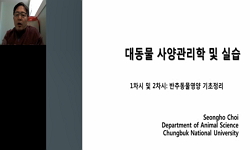This study was designed to examine the characteristics of sawdust and cocopeat bedding materials, including physicochemical properties (Exp. I) and on-farm trial (Exp. II). In Exp. I, the proportion of particle size was in the order of sawdust>coco...
http://chineseinput.net/에서 pinyin(병음)방식으로 중국어를 변환할 수 있습니다.
변환된 중국어를 복사하여 사용하시면 됩니다.
- 中文 을 입력하시려면 zhongwen을 입력하시고 space를누르시면됩니다.
- 北京 을 입력하시려면 beijing을 입력하시고 space를 누르시면 됩니다.



Characteristics of Sawdust and Cocopeat Beddings, and Their Usefulness According to the Fan and Pen Location for Rearing Hanwoo Cattle
한글로보기https://www.riss.kr/link?id=A101810125
- 저자
- 발행기관
- 학술지명
- 권호사항
-
발행연도
2016
-
작성언어
English
-
주제어
Animal Welfare ; Bedding ; Sawdust ; Cocopeat ; Ammonia Emission ; Cattle
-
등재정보
SCIE,SCOPUS,KCI등재
-
자료형태
학술저널
-
수록면
444-454(11쪽)
- DOI식별코드
- 제공처
-
0
상세조회 -
0
다운로드
부가정보
다국어 초록 (Multilingual Abstract)
This study was designed to examine the characteristics of sawdust and cocopeat bedding materials, including physicochemical properties (Exp. I) and on-farm trial (Exp. II). In Exp. I, the proportion of particle size was in the order of sawdust>cocopeat India>cocopeat Vietnam (p<0.05), and cocopeat contained higher proportion of small particles ($250{\mu}m$+below $250{\mu}m$) than sawdust, causing a dust production problem. Bulk density was cocopeat India>cocopeat Vietnam>sawdust (p<0.05), thus cocopeat treatments showed 4.4 times higher bedding cost than sawdust. The water absorption rates were 702.0% in cocopeat India, 678.3% in cocopeat Vietnam, and 444.0% in sawdust, showing cocopeat had approximately 1.5 times higher water absorption rate than sawdust. Moisture evaporation rates after 12 h of air blowing (2.00 m/s) were higher (p<0.05) in cocopeat Vietnam (80.4%) than sawdust (71.2%) and cocopeat India (72.8%). In vitro ammonia emissions were higher (p<0.05) in sawdust ($2.71mg/m^2/h$) than cocopeat India ($1.59mg/m^2/h$) and Vietnam ($1.22mg/m^2/h$), and total ammonia emissions were higher (p<0.05) in sawdust ($37.02mg/m^2$) than cocopeat India ($22.51mg/m^2$) and Vietnam ($13.60mg/m^2$). In Exp. II, an on-farm trial was conducted with 48 Hanwoo cattle in 16 pens using the same bedding materials as in Exp. I, with fan (blowing 2.00 m/s) and no fan treatments, and feed bunk side (FB) and water supply side (WS) within a pen (4.5 m, $width{\times}9.0m$, length). Beddings were replaced with fresh bedding materials when moisture concentrations were over 65%. No interactions among treatments were detected for moisture concentration and increment rates, and ammonia concentrations, but a significant effect was observed (p<0.01) for each of the treatments. Both concentrations and increment rate of moisture were higher (p<0.01) in the beddings without fan than with fan. Moisture concentrations and increment rate within a pen were also higher (p<0.01) in FB than WS. Thus, the whole no-fan-FB and sawdust-fan-FB were replaced with fresh bedding material between 4 to 5 experimental weeks. The ammonia concentrations and pH of beddings were not significantly different among treatments. Therefore, using cocopeat bedding with a blowing fan can extend twice the bedding utilization period, and WS within a pen showed twice the bedding-life compared to FB. Despite the outstanding characteristics of cocopeat compared with sawdust, using cocopeat as an alternative for sawdust bedding is not recommended for cattle management, considering it has 4.4 times higher bedding cost and a dust production problem.
동일학술지(권/호) 다른 논문
-
- Asian Australasian Association of Animal Production Societies
- Jiao, Xiao-Li
- 2016
- SCIE,SCOPUS,KCI등재
-
Cheese Microbial Risk Assessments - A Review
- Asian Australasian Association of Animal Production Societies
- Choi, Kyoung-Hee
- 2016
- SCIE,SCOPUS,KCI등재
-
Characterizing Milk Production Related Genes in Holstein Using RNA-seq
- Asian Australasian Association of Animal Production Societies
- Seo, Minseok
- 2016
- SCIE,SCOPUS,KCI등재
-
Effect of Antioxidant Flavonoids (Quercetin and Taxifolin) on In vitro Maturation of Porcine Oocytes
- Asian Australasian Association of Animal Production Societies
- Kang, Jung-Taek
- 2016
- SCIE,SCOPUS,KCI등재





 ScienceON
ScienceON



